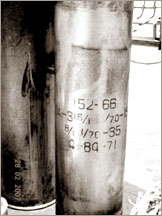Calm before a storm... Tigers stockpiling weapons

From the early days of the separatist insurgency, Velupillai
Prabhakaran decided to be different from the rest of the over half a
dozen militant groups fighting for a separate state. Of course, like
other groups, the LTTE relied on Indian assistance. But, regular
bickering by his Indian handlers disturbed the Tiger chieftain.
As differences surfaced, Prabhakaran, embarked on a different
journey.
He sent his erstwhile friend and former merchant mariner,
Tharmalingham Shunmugham, alias Kumaran Pathmanathan better known as KP
to explore the underground arms market in South East Asia and South West
Asia.
Since then for almost two decades, the Tiger arms smuggling wing,
known as KP department access weapons from markets in Eastern Europe;
Southeast, Northeast and Southwest Asia; and, most recently, southern
Africa.
The arms smuggling wing is one of the most secretive of the group's
international operations.
Most wanted list
KP, on the Interpol Most wanted list, is notably a nondescript in
person and a seasoned undercover operator, who is believed to be using
some 20 passports reportedly to his name.
He is linked by both Western and Sri Lankan intelligence sources to
arms deals that have been ranging from Croatia to South Africa. His main
operating bases have been Rangoon, Bangkok, and, in the late nineteen
nineties Johannesburg, with most of his transactions financed through
established bank accounts held in London.
|

Shells of 152mm artillery recovered |
According to the experts on insurgency, Pathmanathan establishes his
brokers and intermediaries around the world through a sophisticated
human export ring that draws on the LTTE's general human-smuggling
capabilities.
Tamil expatriates in the west such as Australia, Canada, Europe and
the United States allegedly obtain visas for overseas countries (where
such applications are less likely to arouse suspicion). Potential agents
with somewhat similar facial features of the original applicants are
then chosen and travel, with a LTTE representative, to the selected
states. The impersonators are left to apply for refugee status (either
in the chosen state or an adjacent country), while the LTTE rep returns
with the original pass- ports, handing them back to their rightful
owners, according to a study by RAND cooperation.
At the heart of the KP Department's operations is a highly active
shipping network, known informally within the group as the "Sea
Pigeons."
Indeed, the termination of Indian support after the Indo-Lanka peace
accord saw a greater energy of LTTE's international operations being
pumped to build its arms smuggling wing.
That saw a rapid expansion of its fleet, which according to recent
intelligence reports, numbers at least 11 deep-sea freighters, the
majority of which reportedly sail under Honduran, Liberian, or
Panamanian flags, countries known for lax registry requirements.
One already known ploy is that the "Sea Pigeons" repeatedly change
the names and flags during the transport of illegal cargo, which
confound international tracking and monitoring efforts.
The merchant Navy of the Tigers most of the time, engage in the
legitimate transport of commercial goods such as cement, oil,tea,rice,
paddy and fertilizer, but, when required will be deployed in illegal
arms smuggling for the Tigers.
The LTTE's source of weaponry range from Afghanistan to the South
East Asia, former Soviet Bloc and Eastern European countries.
Booming under-ground arms market have emerged in the former war zones
of South East Asia and South West Asia.
Especially, in Cambodia, Myanmar, and Afghanistan, where the group
has obtained every- thing from rapid-fire pistols and assault rifles to
rocket-propelled grenades and surface-to-air missiles. Ammunition
requirements- including mortar, artillery, and 12.7-mm machine-gun
rounds-are mostly met by purchases from Bulgaria, the Czech Republic.
In the beginning of the Third Eelam war following the break up of
peace talks with the Kumaratunga Administration, the Tigers shot down
two Avro Aircraft with Afghan Mujahedin provided SAM missiles. Many of
the weapons acquired from Afghanistan had initially been supplied by the
United States in support of the Mujahedin to fight the Soviet-backed
regime.
There are also intelligence reports that the LTTE is pushing to
extend the reaches of its global arms network to South Africa. Country's
borders with once war zones of Mozambique and Angola, a heaven for
underground arms market is an incentive to the LTTE to open its offices
in South Africa. Sizeable Tamil minority in South Africa and absence of
any laws dealing with terrorism in the post-Apartheid Africa stand for
the LTTE's comfort.
There are several groups in South Africa that are openly supportive
of the LTTE. In the recent times,Thailand has emerged as the main
logistical interface between these various international weapons sources
and the Tamil separatist war in Sri Lanka. There are reports of
increasing presence of LTTE arms dealers in Indonesia and Cambodia. The
third in command of the KP department, Pratheepan Thavaraja was arrested
in January in Indonesia.
The LTTE operated out of Thailand for most of the 1990s, though it is
only during the past eight years that the country emerged as the key hub
in the group's international arms network. Prior to this, the Tigers had
relied on bases off Cambodia and Burma.
Usual practice in the LTTE arms smuggling is that arms cargo is
delivered by the Tiger merchant Navy, Sea Pigeons to the warehouses in
the Southern coast of Thailand. From there, the armament is off loaded
to smaller vessels for the final 1,900 km trip to the landing ports in
Mullaitivu.
As the Tiger offensive in August to lay seige to the city of Jaffna
were heading to a close, security forces noticed a scale down in the
Tiger artillery and mortar attack.
As the troops set for the capture of Sampur, again, it was evident
that the Tigers were firing mortars sparsely to a striking contrast to
artillery and mortar barrages which rained on the Security forces
Defence Lines during the first two weeks of the Jaffna offensive.
The understanding in the military circles was that the Tigers were
running short of artillery and mortar shells.
To further complicate the situation, the Navy destroyed a suspected
LTTE arms smuggling vessel off Mullativu, alleged to be transporting 200
Tons of arms cargo.
Beefed up travel cordon
With the beefed up naval cordon off the Sri Lankan waters, it became
increasing by difficult for the LTTE to rearm as the government stepped
up its military campaign.
During the recent past, the Navy foiled several attempts by the LTTE
at arms smuggling, sinking several trawlers, some converted as
logistical craft off the North-Western Coast. The military planners also
viewed the recent lull in the Battle front, where the Tigers didn't opt
for a major offensive since the miscalculated Jaffna siege, as the calm
before a storm.
Understandably, the Tigers are licking the wounds of the costly
offensive on the security forces defence lines in the Jaffna Peninsula
as well as the recent setback in Vakarai. The latter, despite, most of
its achievements remain in obscurity inflicting heavy casualties on the
Tiger military machinery. Though it was the material loss of the Tigers,
which amounted to the largest cache of Tiger armament recovered by the
troops, the huge loss of the cadre would have a greater impact on the
Tiger military machinery.
According to the senior security force sources, an estimated 716.
Tiger cadres were killed during the three months of jungle warfare in
the coastal stretch of Vakarai, Kathiravei and Verugal.
These figures could not be independently verified, but, should they
be reflective of the battle ground realities, that along amount to ten
percent of the fighting cadre of the LTTE. Under realistic estimates,
the total fighting cadre of the LTTE could not be more than 7,500.
What was noticeable during the previous Tiger offensives, most
notably, during "the Unceasing Waves," which over ran the Elephant Pass
Military Garrison, the LTTE supplemented its lower man power with a high
volume of arsenal. The Tigers deployed 152mm,130mm, 122 mm artillery
guns and 120 mm mortars along with several rudimentary Multi Barrel
Rocket Launchers believed to be similar to Katyusha Rocket Launchers
used by Hizbullah guerrillas.
The heavy volume of indirect force took the security forces by
surprise and brought the Tigers to the city gates of Jaffna.
Recent lull is a forewarning of the rearming and regrouping of the
LTTE. All indications are that the LTTE is stockpiling weapons for a
major onslaught.
It was the success of the Navy, which foiled several attempts of arms
smuggling that stand to be an obstacle.
But, in the vast Sri Lankan waters, it is naive to assume that every
sea Tiger boat ended at the Navy cordon. While some were captured, it is
most possible some others could have succeeded on their journey.
The usual practice of the Tigers is that cargo of arms are loaded to
the trawlers in the deep sea. Trawlers transport the cargo to the Tiger
landing ports in the Eastern Coast. And the recent phenomena is that
with the stepped up Naval patrol in the Eastern Coast, several Tiger
logistical craft were blown up by the Navy off the North-Western Coast.
Two Naval Fast Attack Craft were on routine patrol off Pulmudai on
Tuesday night. Just before midnight, their radars flashed a flotilla of
sea Tiger boats. The flotilla of 14 boats were launched from Nayaru and
heading southwards hugging the coast.
The crew on board the Dovra FACs engaged with the sea Tiger boats.
Ground troops fired air burst of artillery targeting the sea Tiger
boats.
During the resultant fire fight, two sea Tiger boats were destroyed.
The others fled towards Nayaru towing the 03 craft which sustained
damages.
The Navy said 15 LTTE cadres were believed dead. 02 sailors also
sustained minor injuries.
The LTTE had named three sea Tigers, who were the second rung leaders
as dead in the Tuesday's battle. They are Aruna Karunan, a Lt.Colonel in
the Tiger rank and Anal Puli and female sea tiger Deshamalar, both are
Majors in the LTTE rank.
The destination of the sea tiger flotilla is not known. But, the fact
a senior sea Tiger leader was on board a sea tiger boat is indicative
that the flotilla was proceeding for a mission important.
Could it be a mere coincidence when the Navy destroyed a suspected
arms smuggling vessel 180 nautical miles off Point Dondra.
A Navy Offshore Patrol Craft intercepted the suspicious vessel in the
early morning of Wednesday.
The ship did not carry a flag, nor did it display its registered No
of the International Maritime Organisation (IMO). The crew on board the
OPV contacted the suspicious vessel over channel 16 of the Maritime
Frequencies for information. But, the crew found the information
provided by the suspicious vessel was incompatible with the records of
Loyds Ship Registry.
Final destination
The suspicious ship was ordered to berth at the Galle Harbour for
inspection. But, not heeding to instructions, the ship headed towards
international waters.
The Navy fired warning shots. The Navy spokesman Commander
D.K.P.Dasanayake said the OPV was fired upon from the direction of the
ship with medium calibre guns.
The Navy opened fire which set the ship ablaze. A series of
explosions were heard from the sinking vessel, which suggested that the
ship could be transporting artillery shells.
Later the Navy frogman recovered several shells of artillery.
The Navy spokesman said the sunken ship had the capacity to transport
a cargo of thousand tonnes. Meaning the ship could have transported
10,000 of artillery shells.
Had the Tigers succeeded smuggling the arms cargo, it is safe to
assume that the next major Tiger offensive would have been a couple of
weeks ahead. But, with the Navy beefing up the naval cordon and sea
tigers desperately trying to sneak in, rough seas are ahead.
[email protected]
|
